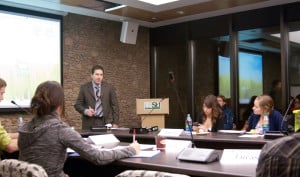DARYL HOFMANN
& ISHMAEL N. DARO

USSU lawyer Brendan Tumback speaking to University Students’ Council Nov. 24.
At the Nov. 10 AGM for the USSU, an amendment to section 28 of the union’s bylaw was voted down that would have given the two groups on campus two councillors each. All student groups with more than 1,000 members get two councillors. Student groups with fewer members get one councillor.
As it stands, however, councillors for international and indigenous students must come from the International Students’ Association and the Indigenous Students’ Council, respectively. The ISA does not currently exist, and the ISC must prove that it has over 1,000 members — a difficult feat given that membership in the ISC is voluntary.
The situation was explained to council on Nov. 24 by the USSU’s lawyer, Brendan Tumback.
Ironically, it was exactly these two groups that worked tirelessly at the Nov. 10 annual general meeting to vote the amendment down. Many argued that taking the ISA and ISC out of the bylaw in favour of direct elections by international and indigenous students would harm the ability of the two students’ societies to function properly.
Since the bylaw did not remove reference to the ISA and remains unchanged, two international students who were elected to the USC cannot take their seats now.
“Unfortunately as the bylaw was not amended, those elected representatives, in our opinion, have no standing under the current bylaw,” said Tumback. “Also it’s my understanding that the ISA is not in existence at this time, and what that means is that unless that entity is brought back and another election is held, they will not be eligible to have representation on council at this time.”
As the bylaw was not amended and still refers to the specific student group rather than all indigenous students, representation on USC will remain at one councillor for indigenous students.
“In order for the ISC to have two councillors, they would have to provide the USSU with some sort of satisfactory documentary evidence that their membership is 1,000 or more. Now that’s the same across the board for all the colleges as well,” Tumback said.
USSU General Manager Caroline Cottrell said that PAWS “would need to have a mechanism to identify the students who are members of the Indigenous Students’ Council, and only those people would be able to vote. If the term ‘council’ was dropped, then anyone who self-identifies through the enrolment process at the University of Saskatchewan would be eligible to vote.”
Students’ council now has to go back to the drawing board to deal with proper representation of international and indigenous students.
If the ISA starts up again — perhaps by spring — they could hold another round of elections for councillors. However, they would still be restricted to a single councillor if they cannot prove they have more than 1,000 members. To rectify this, the USSU could hold a special general meeting in spring to vote on an amendment similar to the defeated one from the AGM — one that maintains the ISA and ISC as the legitimate representatives of international and indigenous students but that also recognizes all self-identified international and indigenous students as automatic members of those groups.
ISC president Ryan Moccasin said he wasn’t surprised by what he heard from the USSU lawyer and that he looked forward to coming up with a new amendment that is both inclusive of the ISA and ISC student groups and affords them two seats each to reflect the international and indigenous populations at the U of S.
“Going forward, we’re going to sit down with the USSU, the ISA and ISC and see where everybody can agree on something,” said Moccasin.
“What we’re going to make sure is that we sit down at the table and talk about it before the SGM happens, which unfortunately didn’t happen with the AGM.”
—
Photo: Ishmael N. Daro/The Sheaf